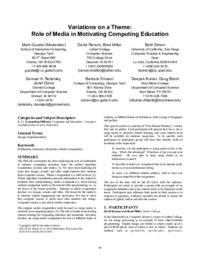Variations on a themerole of media in motivating computing education
Mark Guzdial, David Ranum, Bradley N. Miller, Beth Simon, Barbara J. Ericson, Samuel A. Rebelsky, Janet Davis, Deepak Kumar, Douglas S. Blank
Publikationsdatum:
Zu finden in: SIGCSE 2010 (Seite 66 bis 67), 2009
|
 |
 Diese Seite wurde seit 5 Jahren inhaltlich nicht mehr aktualisiert.
Unter Umständen ist sie nicht mehr aktuell.
Diese Seite wurde seit 5 Jahren inhaltlich nicht mehr aktualisiert.
Unter Umständen ist sie nicht mehr aktuell.
 Zusammenfassungen
Zusammenfassungen

The SIGCSE community has been exploring the role of multimedia to enhance computing education since the earliest algorithm visualization systems and studies [1]. Media Computation is a shift in focus [2]. Where algorithm visualization presents information to the student to facilitate their understanding, media computation is about having students manipulate media as the data for their programming, i.e., as the focus of the course activities. Students in media computation produce new images, sounds, and video. We aim to show that computer science is about more than numbers and strings. Computer science is also about creative expression. The original media computation work focused on using media to motivate non-computing majors [2]. The role of media in motivating student learning for computing education has broadened. Inventive teachers are using media computation for lots of different kinds of students, at different kinds of institutions, with a range of languages and toolkits. This special session is a mixture of "Five Minute Madness," science fair, and art gallery. Each participant will present how he or she is using media to motivate student learning, and some student work will be available for audience inspection
 Dieses Konferenz-Paper erwähnt ...
Dieses Konferenz-Paper erwähnt ...
 Dieses Konferenz-Paper erwähnt vermutlich nicht ...
Dieses Konferenz-Paper erwähnt vermutlich nicht ... 
 Nicht erwähnte Begriffe | Informatikunterricht in der Schule |
 Tagcloud
Tagcloud
 Anderswo finden
Anderswo finden
 Volltext dieses Dokuments
Volltext dieses Dokuments
 |  Variations on a theme: Fulltext at the ACM Digital Library ( Variations on a theme: Fulltext at the ACM Digital Library ( : :  , 401 kByte; , 401 kByte;  : :  Link unterbrochen? Letzte Überprüfung: 2020-11-28 Letzte erfolgreiche Überprüfung: 2020-08-11) Link unterbrochen? Letzte Überprüfung: 2020-11-28 Letzte erfolgreiche Überprüfung: 2020-08-11) |
 Anderswo suchen
Anderswo suchen 
 Beat und dieses Konferenz-Paper
Beat und dieses Konferenz-Paper
Beat hat Dieses Konferenz-Paper während seiner Zeit am Institut für Medien und Schule (IMS) ins Biblionetz aufgenommen. Beat besitzt kein physisches, aber ein digitales Exemplar. Eine digitale Version ist auf dem Internet verfügbar (s.o.). Aufgrund der wenigen Einträge im Biblionetz scheint er es nicht wirklich gelesen zu haben. Es gibt bisher auch nur wenige Objekte im Biblionetz, die dieses Werk zitieren.









 Algorithmus
Algorithmus Lernen
Lernen Multimedia
Multimedia Programmieren
Programmieren
 Biblionetz-History
Biblionetz-History